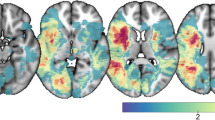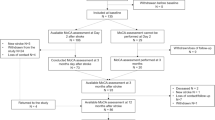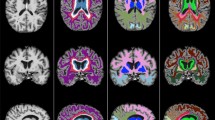Abstract
We examined the patterns and variability of post-stroke recovery in multiple behavioural domains. A large cohort of first-time stroke patients with heterogeneous lesions was studied prospectively and longitudinally at one to two weeks, three months and one year after the stroke using structural magnetic resonance imaging to measure lesion anatomy and 44 neuropsychological tests to assess behavioural outcomes. Impairment was described at all time points by a few clusters of correlated deficits. The time course and magnitude of recovery was similar across behavioural domains, with change scores largely proportional to the initial deficit and most recovery occurring within the first three months. Damage to specific white matter tracts produced poorer recovery for several domains: attention (superior longitudinal fasciculus II/III), language (posterior arcuate fasciculus) and motor (corticospinal tract). Finally, after accounting for the severity of the initial deficit, language and visual memory recovery was worse for those with lower levels of education, while the occurrence of multiple deficits negatively impacted attention recovery.
This is a preview of subscription content, access via your institution
Access options
Access Nature and 54 other Nature Portfolio journals
Get Nature+, our best-value online-access subscription
$29.99 / 30 days
cancel any time
Subscribe to this journal
Receive 12 digital issues and online access to articles
$119.00 per year
only $9.92 per issue
Buy this article
- Purchase on Springer Link
- Instant access to full article PDF
Prices may be subject to local taxes which are calculated during checkout





Similar content being viewed by others
References
Ringman, J. M., Saver, J. L., Woolson, R. F., Clarke, W. R. & Adams, H. P. Frequency, risk factors, anatomy, and course of unilateral neglect in an acute stroke cohort. Neurology 63, 468–474 (2004).
Nys, G. M. S. et al. Cognitive disorders in acute stroke: prevalence and clinical determinants. Cerebrovasc. Dis. 23, 408–416 (2007).
Appelros, P., Karlsson, G. M., Seiger, A. & Nydevik, I. Neglect and anosognosia after first-ever stroke: incidence and relationship to disability. Acta Derm. Venereol. 34, 215–220 (2002).
Buxbaum, L. J. et al. Hemispatial neglect: subtypes, neuroanatomy, and disability. Neurology 62, 749–756 (2004).
Rathore, S. S., Hinn, A. R., Cooper, L. S., Tyroler, H. A. & Rosamond, W. D. Characterization of incident stroke signs and symptoms: findings from the atherosclerosis risk in communities study. Stroke 33, 2718–2721 (2002).
Zandieh, A. et al. The underlying factor structure of National Institutes of Health Stroke Scale: an exploratory factor analysis. Int. J. Neurosci. 122, 140–144 (2011).
Lyden, P., Claesson, L., Havstad, S., Ashwood, T. & Lu, M. Factor analysis of the National Institutes of Health Stroke Scale in patients with large strokes. Arch. Neurol. 61, 1677–1680 (2004).
Corbetta, M. et al. Common behavioral clusters and subcortical anatomy in stroke. Neuron 85, 927–941 (2015).
Carter, A. R. et al. Resting interhemispheric functional magnetic resonance imaging connectivity predicts performance after stroke. Ann. Neurol. 67, 365–375 (2010).
Wang, Y., Chen, H., Gong, Q., Shen, S. & Gao, Q. Analysis of functional networks involved in motor execution and motor imagery using combined hierarchical clustering analysis and independent component analysis. Magn. Reson. Imaging 28, 653–660 (2010).
Urbin, M. A., Hong, X., Lang, C. E. & Carter, A. R. Resting-state functional connectivity and its association with multiple domains of upper-extremity function in chronic stroke. Neurorehab. Neural Re. 28, 761–769 (2014).
Ovadia-Caro, S. et al. Longitudinal effects of lesions on functional networks after stroke. J. Cereb. Blood Flow Metab. 33, 1279–1285 (2013).
van Meer, M. P. A. et al. Recovery of sensorimotor function after experimental stroke correlates with restoration of resting-state interhemispheric functional connectivity. J. Neurosci. 30, 3964–3972 (2010).
He, B. J. et al. Breakdown of functional connectivity in frontoparietal networks underlies behavioral deficits in spatial neglect. Neuron 53, 905–918 (2007).
Baldassarre, A. et al. Large-scale changes in network interactions as a physiological signature of spatial neglect. Brain 137, 3267–3283 (2014).
Siegel, J. S. et al. Disruptions of network connectivity predict impairment in multiple behavioral domains after stroke. Proc. Natl Acad. Sci. USA 113, E4367–E4376 (2016).
Skilbeck, C. E., Wade, D. T., Hewer, R. L. & Wood, V. A. Recovery after stroke. J. Neurol. 46, 5–8 (1983).
Kotila, M., Waltimo, O., Niemi, M. L., Laaksonen, R. & Lempinen, M. The profile of recovery from stroke and factors influencing outcome. Stroke 15, 1039–1044 (1984).
Wade, D. T., Wood, V. A. & Hewer, R. L. Recovery after stroke—the first 3 months. J. Neurol. Neurosurg. Psychiatry 48, 7–13 (1985).
Duncan, P. W. et al. Similar motor recovery of upper and lower extremities after stroke. Stroke 25, 1181–1188 (1994).
Stone, S. P., Patel, P., Greenwood, R. J. & Halligan, P. W. Measuring visual neglect in acute stroke and predicting its recovery: the visual neglect recovery index. J. Neurol. Neurosurg. Psychiatry 55, 431–436 (1992).
Kertesz, A. & McCabe, P. Recovery patterns and prognosis in aphasia. Brain 100, 1–18 (1977).
Levine, D. N., Warach, J. D., Benowitz, L. & Calvanio, R. Left spatial neglect: effects of lesion size and premorbid brain atrophy on severity and recovery following right cerebral infarction. Neurology 36, 362–366 (1986).
Hendricks, H. T., van Limbeek, J., Geurts, A. C. & Zwarts, M. J. Motor recovery after stroke: a systematic review of the literature. Arch. Phys. Med. Rehabil. 83, 1629–1637 (2002).
Prabhakaran, S. et al. Inter-individual variability in the capacity for motor recovery after ischemic stroke. Neurorehab. Neural Re. 22, 64–71 (2007).
Lazar, R. M. et al. Improvement in aphasia scores after stroke is well predicted by initial severity. Stroke 41, 1485–1488 (2010).
Coupar, F., Pollock, A., Rowe, P., Weir, C. & Langhorne, P. Predictors of upper limb recovery after stroke: a systematic review and meta-analysis. Clin. Rehabil. 26, 291–313 (2012).
Karnath, H.-O., Rennig, J., Johannsen, L. & Rorden, C. The anatomy underlying acute versus chronic spatial neglect: a longitudinal study. Brain 134, 903–912 (2011).
Rengachary, J., He, B. J., Shulman, G. L. & Corbetta, M. A behavioral analysis of spatial neglect and its recovery after stroke. Front. Hum. Neurosci. 5, 29 (2011).
Dronkers, N. F., Wilkins, D. P., Van Valin, R. D. Jr, Redfern, B. B. & Jaeger, J. J. Lesion analysis of the brain areas involved in language comprehension. Cognition 92, 145–177 (2004).
Lo, R., Gitelman, D., Levy, R., Hulvershorn, J. & Parrish, T. Identification of critical areas for motor function recovery in chronic stroke subjects using voxel-based lesion symptom mapping. Neuroimage 49, 9–18 (2010).
Schaechter, J. D. et al. Microstructural status of ipsilesional and contralesional corticospinal tract correlates with motor skill in chronic stroke patients. Hum. Brain Mapp. 30, 3461–3474 (2009).
Duncan, P. W., Goldstein, L. B., Matchar, D., Divine, G. W. & Feussner, J. Measurement of motor recovery after stroke. Outcome assessment and sample size requirements. Stroke 23, 1084–1089 (1992).
Nijboer, T. C. W., Kollen, B. J. & Kwakkel, G. The impact of recovery of visuo-spatial neglect on motor recovery of the upper paretic limb after stroke. PLoS ONE 9, e100584 (2014).
Pedersen, P. M., Stig Jorgensen, H., Nakayama, H., Raaschou, H. O. & Olsen, T. S. Aphasia in acute stroke: incidence, determinants, and recovery. Ann. Neurol. 38, 659–666 (1995).
Sunderland, A. et al. Enhanced physical therapy improves recovery of arm function after stroke. A randomised controlled trial. J. Neurol. Neurosurg. Psychiatry 55, 530–535 (1992).
Lövblad, K. O. et al. Ischemic lesion volumes in acute stroke by diffusion-weighted magnetic resonance imaging correlate with clinical outcome. Ann. Neurol. 42, 164–170 (1997).
Winters, C., van Wegen, E. E. H., Daffertshofer, A. & Kwakkel, G. Generalizability of the proportional recovery model for the upper extremity after an ischemic stroke. Neurorehab. Neural Re. 29, 614–622 (2015).
Staff, R. T., Murray, A. D., Deary, I. J. & Whalley, L. J. What provides cerebral reserve? Brain 127, 1191–1199 (2004).
Perneczky, R., Diehl-Schmid, J., Pohl, C., Drzezga, A. & Kurz, A. Non-fluent progressive aphasia: cerebral metabolic patterns and brain reserve. Brain Res. 1133, 178–185 (2007).
González-Fernández, M. et al. Formal education, socioeconomic status, and the severity of aphasia after stroke. Arch. Phys. Med. Rehabil. 92, 1809–1813 (2011).
Connor, L. T., Obler, L. K., Tocco, M., Fitzpatrick, P. M. & Albert, M. L. Effect of socioeconomic status on aphasia severity and recovery. Brain Lang. 78, 254–257 (2001).
Naeser, M. A. et al. Aphasia with predominantly subcortical lesion sites: description of three capsular/putaminal aphasia syndromes. Arch. Neurol. 39, 2–14 (1982).
Alexander, M. P., Naeser, M. A. & Palumbo, C. L. Correlations of subcorticalct lesion sites and aphasia profiles. Brain 110, 961–988 (1987).
Damasio, A. R. & Damasio, H. Brain and language. Sci. Am. 267, 88–95 (1992).
Ptak, R. & Schnider, A. The attention network of the human brain: relating structural damage associated with spatial neglect to functional imaging correlates of spatial attention. Neuropsychologia 49, 3063–3070 (2011).
Mort, D. J. et al. The anatomy of visual neglect. Brain 126, 1986–1997 (2003).
Rorden, C. & Karnath, H.-O. Using human brain lesions to infer function: a relic from a past era in the fMRI age? Nat. Rev. Neurosci. 5, 813–819 (2004).
Karnath, H.-O. et al. Normalized perfusion MRI to identify common areas of dysfunction: patients with basal ganglia neglect. Brain 128, 2462–2469 (2005).
Husain, M. & Rorden, C. Non-spatially lateralized mechanisms in hemispatial neglect. Nat. Rev. Neurosci. 4, 26–36 (2003).
De Schotten, M. T. et al. Damage to white matter pathways in subacute and chronic spatial neglect: a group study and 2 single-case studies with complete virtual ‘in vivo’ tractography dissection. Cereb. Cortex 24, 691–706 (2014).
Doricchi, F., Thiebaut de Schotten, M., Tomaiuolo, F. & Bartolomeo, P. White matter (dis)connections and gray matter (dys)functions in visual neglect: gaining insights into the brain networks of spatial awareness. Cortex 44, 983–995 (2008).
Bartolomeo, P., Thiebaut de Schotten, M. & Doricchi, F. Left unilateral neglect as a disconnection syndrome. Cereb. Cortex 17, 2479–2490 (2007).
Carter, A. R. et al. Resting interhemispheric functional magnetic resonance imaging connectivity predicts performance after stroke. Ann. Neurol. 67, 365–375 (2010).
Wang, L. et al. Dynamic functional reorganization of the motor execution network after stroke. Brain 133, 1224–1238 (2010).
Ramsey, L. E. et al. Normalization of network connectivity in hemispatial neglect recovery. Ann. Neurol. 80, 127–141 (2016).
Kwakkel, G., Kollen, B. & Twisk, J. Impact of time on improvement of outcome after stroke. Stroke 37, 2348–2353 (2006).
Murphy, T. H. & Corbett, D. Plasticity during stroke recovery: from synapse to behaviour. Nat. Rev. Neurosci. 10, 861–872 (2009).
Ge, S., Yang, C.-H., Hsu, K.-S., Ming, G.-L. & Song, H. A critical period for enhanced synaptic plasticity in newly generated neurons of the adult brain. Neuron 54, 559–566 (2007).
Biernaskie, J. Efficacy of rehabilitative experience declines with time after focal ischemic brain injury. J. Neurosci. 24, 1245–1254 (2004).
Dromerick, A. W. et al. Critical periods after stroke study: translating animal stroke recovery experiments into a clinical trial. Front. Hum. Neurosci. 9, 1–13 (2015).
Chollet, F. et al. Fluoxetine for motor recovery after acute ischaemic stroke (FLAME): a randomised placebo-controlled trial. Lancet Neurol. 10, 123–130 (2011).
Ng, K. L. et al. Fluoxetine maintains a state of heightened responsiveness to motor training Early after stroke in a mouse model. Stroke 46, 2951–2960 (2015).
Fox, M. D., Halko, M. A., Eldaief, M. C. & Pascual-Leone, A. Measuring and manipulating brain connectivity with resting state functional connectivity magnetic resonance imaging (fcMRI) and transcranial magnetic stimulation (TMS). Neuroimage 62, 2232–2243 (2012).
Liew, S.-L., Santarnecchi, E., Buch, E. R. & Cohen, L. G. Non-invasive brain stimulation in neurorehabilitation: local and distant effects for motor recovery. Front. Hum. Neurosci. 8, 77–91 (2014).
Siegel, J. S., Snyder, A. Z., Ramsey, L., Shulman, G. L. & Corbetta, M. The effects of hemodynamic lag on functional connectivity and behavior after stroke. J. Cereb. Blood Flow Metab. 36, 2162–2172 (2015).
Acknowledgements
The authors received funding from the following grants: R01 HD061117-05 and R01 NS095741 (M.C.). The funders had no role in study design, data collection and analysis, decision to publish, or preparation of the manuscript.
Author information
Authors and Affiliations
Contributions
Study concept and design by M.C., G.L.S., L.E.R. and C.E.L. Data acquisition was done by L.E.R and J.S.S. Analysis was done by L.E.R., J.S.S. and M.S. The manuscript was written by L.E.R., M.C. and G.L.S.
Corresponding author
Ethics declarations
Competing interests
The authors declare no competing interests.
Supplementary information
Supplementary Information
Supplementary Figures 1–3 and Supplementary Tables 1–4 (PDF 501 kb)
Rights and permissions
About this article
Cite this article
Ramsey, L., Siegel, J., Lang, C. et al. Behavioural clusters and predictors of performance during recovery from stroke. Nat Hum Behav 1, 0038 (2017). https://doi.org/10.1038/s41562-016-0038
Received:
Accepted:
Published:
DOI: https://doi.org/10.1038/s41562-016-0038
This article is cited by
-
The role of cognitive control and naming in aphasia
Biologia Futura (2024)
-
High-density transcranial direct current stimulation to improve upper limb motor function following stroke: study protocol for a double-blind randomized clinical trial targeting prefrontal and/or cerebellar cognitive contributions to voluntary motion
Trials (2023)
-
Development and usability of a hospital standardized ADL ratio (HSAR) for elderly patients with cerebral infarction: a retrospective observational study using administrative claim data from 2012 to 2019 in Japan
BMC Geriatrics (2023)
-
OptiCogs: feasibility of a multicomponent intervention to rehabilitate people with cognitive impairment post-stroke
Pilot and Feasibility Studies (2023)
-
Can specific virtual reality combined with conventional rehabilitation improve poststroke hand motor function? A randomized clinical trial
Journal of NeuroEngineering and Rehabilitation (2023)



